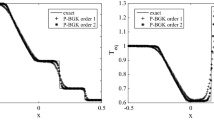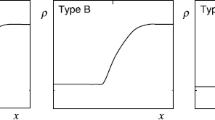Abstract
One of the most significant achievements in rarefied gas theory in the last 20 years is the Krook model for the Boltzmann equation [1]. The Krook model relaxation equation retains all the features of the Boltzmann equation which are associated with free molecular motion and describes approximately, in a mean-statistical fashion, the molecular collisions. The structure of the collisional term in the Krook formula is the simplest of all possible structures which reflect the nature of the phenomenon. Careful and thorough study of the model relaxation equation [2–4], and also solution of several problems for this equation, have aided in providing a deeper understanding of the processes in a rarefied gas. However, the quantitative results obtained from the Krook model equation, with the exception of certain rare cases, differ from the corresponding results based on the exact solution of the Boltzmann equation. At least one of the sources of error is obvious. It is that, in going over to a continuum, the relaxation equation yields a Prandtl number equal to unity, while the exact value for a monatomic gas is 2/3.
In a comparatively recent study [5] Holway proposed the use of the maximal probability principle to obtain a model kinetic equation which would yield in going over to a continuum the expressions for the stress tensor and the thermal flux vector with the proper viscosity and thermal conductivity.
In the following we propose a technique for constructing a sequence of model equations which provide the correct Prandtl number. The technique is based on an approximation of the Boltzmann equation for pseudo-Maxwellian molecules using the method suggested by the author previously in [6], For arbitrary molecules each approximating equation may be considered a model equation. A comparison is made of our results with those of [5].
Similar content being viewed by others
References
P. L. Bhatnagar, E. P. Gross and M. Krook, “A model for collision processes in gases, I. Small amplitude processes in charged and neutral one-component systems”, Phys. Rev., vol. 94, p. 511, 1954.
M. Krook, “Continuum equations in the dynamics of rarefied gases”, J. Fluid Mech., vol. 6, no. 4, pp. 523–541, 1959.
M. N. Kogan, “On the equations of motion of a rarefied gas”, PMM, vol. 22, no. 4, 1958.
M. N. Kogan, Rarefied Gasdynamics [in Russian], Nauka, Moscow, 1967.
L. H. Holway, “New statistical models in kinetic theory: methods of construction”, Phys. Fluids, vol. 9, no. 9, pp. 1658–1673, 1966.
E. M. Shakhov, “On the approximate kinetic equations in rarefied gas theory”, Izv. AN SSSR, MZhG [Fluid Dynamics], no. 1, 1968.
H. V. Grad, Communications on Pure and Appl. Math., vol. 2, no. 4, 1949.
A. M. Kogan, “Derivation of equations of the Grad type and analysis of their relaxational properties by the entropy maximization method”, PMM, vol. 29, no. 1, 1965.
Author information
Authors and Affiliations
Rights and permissions
About this article
Cite this article
Shakhov, E.M. Generalization of the Krook kinetic relaxation equation. Fluid Dyn 3, 95–96 (1968). https://doi.org/10.1007/BF01029546
Issue Date:
DOI: https://doi.org/10.1007/BF01029546




